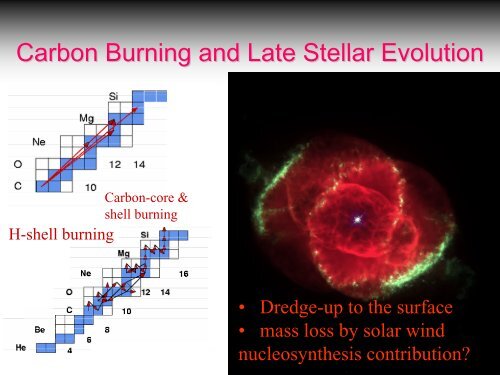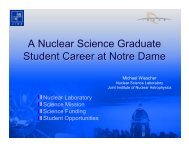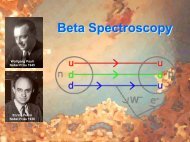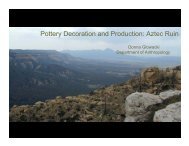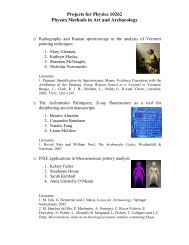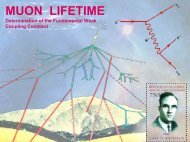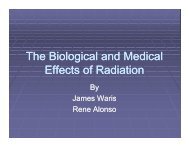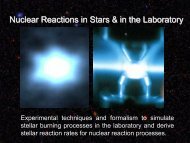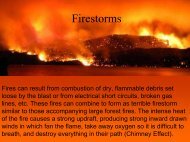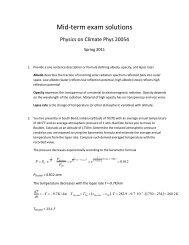8) Carbon Burning & Late Stellar Evolution - ISNAP
8) Carbon Burning & Late Stellar Evolution - ISNAP
8) Carbon Burning & Late Stellar Evolution - ISNAP
You also want an ePaper? Increase the reach of your titles
YUMPU automatically turns print PDFs into web optimized ePapers that Google loves.
<strong>Carbon</strong> <strong>Burning</strong> and <strong>Late</strong> <strong>Stellar</strong> <strong>Evolution</strong><br />
H-shell burning<br />
<strong>Carbon</strong>-core &<br />
shell burning<br />
• Dredge-up to the surface<br />
• mass loss by solar wind<br />
nucleosynthesis contribution?
Nuclear burning & stellar evolution<br />
10<br />
O-ignition<br />
Ne-ignition<br />
Si-ignition<br />
9<br />
C-ignition<br />
log (T c<br />
)<br />
He-ignition<br />
m/M <br />
8<br />
7<br />
H-ignition<br />
0 2 4 6 8 10<br />
log (ρ c<br />
)<br />
6 4 2 0 -2 -4 -6 -8<br />
log (time until core collapse) [y]<br />
Each burning phase is characterized in terms of nuclear particle configurations<br />
hydrogen burning ⇔ CNO proton capture reactions<br />
helium burning ⇔ alpha capture reactions<br />
carbon burning ⇔ C,O fusion reactions and capture reactio<br />
Mass<br />
cut
Subsequent burning sequences<br />
Takes place in environment of increasing density<br />
<strong>Carbon</strong> burning:<br />
Neon burning:<br />
heavy ion burning 12 C+ 12 C ➱ 24 Mg<br />
➱ 20 Ne+α and 23 Na+p<br />
photodissociation of 20 Ne to 16 O and 4 He<br />
because of low α binding energy of 20 Ne<br />
Oxygen burning: heavy ion burning 16 O+ 16 O➱ 28 Si<br />
➱ 24 Mg+α and 27 Al+p<br />
Silicon burning: photodissociation of weakly bound 28 Si<br />
with subsequent p-, α-capture to Fe
<strong>Carbon</strong> <strong>Burning</strong><br />
Conversion of 4 He into 12 C and 16 O<br />
depending on the 12 C(α,γ) 16 O reaction<br />
12<br />
12<br />
12<br />
16<br />
16<br />
16<br />
C(<br />
C(<br />
C(<br />
O(<br />
O(<br />
O(<br />
12<br />
12<br />
12<br />
16<br />
16<br />
16<br />
C,<br />
C,<br />
α)<br />
C,<br />
n)<br />
O,<br />
p)<br />
p)<br />
O,<br />
α)<br />
O,<br />
n)<br />
23<br />
20<br />
23<br />
31<br />
28<br />
31<br />
Na<br />
Ne<br />
Mg<br />
P<br />
Si<br />
S<br />
Q<br />
Q<br />
= 2.240 MeV<br />
= 4.617 MeV<br />
Q = −2.598MeV<br />
Q = 7.628 MeV<br />
Q = 9.594 MeV<br />
Q = 1.499 MeV<br />
16<br />
16<br />
16<br />
O(<br />
O(<br />
O(<br />
12<br />
12<br />
12<br />
C,<br />
p)<br />
C,<br />
α)<br />
C,<br />
n)<br />
27<br />
24<br />
27<br />
Al<br />
Mg<br />
Si<br />
Q<br />
Q<br />
= 7.170 MeV<br />
= 6.771MeV<br />
Q = −0.424<br />
MeV<br />
Wide range of possible<br />
heavy ion<br />
reactions at low energies
The Gamow window for<br />
heavy ion reactions<br />
E<br />
G<br />
ΔE<br />
= 0.122⋅<br />
G<br />
= 0.236⋅<br />
(<br />
2 2 2<br />
Z Z T )<br />
1/3<br />
⋅ ⋅ μ ⋅ [ MeV ]<br />
1<br />
(<br />
2 2 5<br />
Z Z T )<br />
1/ 6<br />
⋅ ⋅ μ ⋅ [ MeV ]<br />
1<br />
1<br />
1<br />
9<br />
9<br />
E G<br />
[MeV]<br />
12<br />
10<br />
8<br />
6<br />
4<br />
2<br />
16O+16O<br />
12C+16O<br />
12C+12C<br />
0<br />
12<br />
C+<br />
12<br />
C<br />
:<br />
E<br />
G<br />
=<br />
2.42⋅T<br />
2/3<br />
9<br />
±<br />
0.75⋅T<br />
5/ 6<br />
9<br />
0 1 2 3<br />
temperature [GK]<br />
16<br />
O+<br />
12<br />
C<br />
:<br />
E<br />
G<br />
=<br />
3.06⋅T<br />
2/3<br />
9<br />
±<br />
0.86⋅T<br />
5/ 6<br />
9<br />
16<br />
O+<br />
16<br />
O<br />
:<br />
E<br />
G<br />
=<br />
3.90⋅T<br />
2/3<br />
9<br />
± 1.34⋅T<br />
5/ 6<br />
9
12<br />
C+ 12 C<br />
different reaction<br />
channels open at<br />
higher temperature<br />
dY<br />
12<br />
dt<br />
C<br />
= −Y<br />
12<br />
C<br />
⋅Y<br />
12<br />
C<br />
⎛<br />
⎜<br />
N<br />
A<br />
συ 12<br />
⋅ ρ ⋅<br />
⎜<br />
⎜<br />
+ N<br />
A<br />
συ<br />
⎜<br />
+ N<br />
⎝<br />
A<br />
συ<br />
C(<br />
12<br />
12<br />
12<br />
C,<br />
α )<br />
C (<br />
C(<br />
12<br />
12<br />
20<br />
C,<br />
p)<br />
C,<br />
n)<br />
Ne<br />
23<br />
23<br />
Na<br />
Mg<br />
⎞<br />
⎟<br />
⎟<br />
⎟<br />
⎟<br />
⎠
Experimental status and goals<br />
unknown S-factor towards lower energies!<br />
new generation of initiatives has started!
S-factor extrapolations for different<br />
nuclear models<br />
The main uncertainty<br />
components are: overall<br />
S-factor extrapolation,<br />
low energy resonances,<br />
exit channel branching!<br />
Presently assumed is<br />
an overall uncertainty<br />
of a factor 2-5 in the<br />
total reaction rate!
Problems of heavy ion burning<br />
20<br />
Ne+α<br />
12<br />
C+ 12 C ⇒ 23 Na+p<br />
23<br />
Mg+n<br />
How to extrapolate, what are branchings<br />
28<br />
Si+α<br />
16<br />
O+ 16 O ⇒ 31 P+p<br />
31<br />
S+n<br />
Times scale for stellar C, O burning<br />
Neutron production in C-burning<br />
& weak s-process nucleosynthesis<br />
White dwarf abundance distribution<br />
& nucleosynthesis in Ne-novae<br />
Ignition conditions for type I SN<br />
Ignition condition for Superbursts
What potential model is appropriate?<br />
Different potential models leads<br />
to different extrapolation of low<br />
energy cross section (S-factor).<br />
Extreme case,<br />
standard potential model<br />
hindrance potential model<br />
Caughlan & Fowler 1988<br />
Gasques et al. 2005<br />
Yakovlev et al. 2006<br />
Jiang et al. 2007
Density & Screening Dependence of Fusion<br />
<br />
Towards higher densities there is an increase in the rate due to<br />
electron screening effects. The free electrons reduce the deflective<br />
Coulomb potential between the two fusioning ions.
Consequences for late stellar burning<br />
Simulations performed for 20 and 60 M ☼<br />
stars, no major differences for<br />
nucleosynthesis except a significant increase in abundance for the longlived<br />
radioactive isotopes 26 Al and 60 Fe and some s-process nuclei. This<br />
suggests impact on n production. That needs further investigation.
Production of Galactic Radioactivity?<br />
Standard<br />
Reduced rates<br />
Chieffi, Limongi 2006<br />
Gasques et al. 2007<br />
Gasques et al. PRC 2007 in print
Resonance Structures in 12 C+ 12 C<br />
Recent data suggest strong but<br />
narrow resonance structures in the<br />
12<br />
C+ 12 C reaction system, which may<br />
enhance the reaction rate<br />
substantially.<br />
Spillane et al. PRL 2007
Reaction rate formalism<br />
N<br />
A<br />
συ<br />
=<br />
N<br />
A<br />
⋅<br />
f<br />
screen<br />
⋅<br />
2<br />
⋅<br />
μ<br />
ΔE<br />
( kT )<br />
G<br />
3/ 2<br />
⋅<br />
S<br />
ij<br />
⋅<br />
e<br />
⎛ 3E<br />
⎜ −<br />
⎝ kT<br />
G<br />
⎞<br />
⎟<br />
⎠<br />
new resonance<br />
nonres<br />
total<br />
N<br />
A<br />
συ = N<br />
A<br />
⋅ f<br />
screen<br />
⋅<br />
2<br />
⋅<br />
μ<br />
ΔE<br />
( kT )<br />
G<br />
3/ 2<br />
⋅ S<br />
ij<br />
⋅e<br />
⎛ 3E<br />
⎜ − G<br />
⎝ kT<br />
⎞<br />
⎟<br />
⎠<br />
Additional resonance causes significant enhancement of low<br />
temperature rate, more resonances could contribute more strongly.


